Formulations
Products
Quick Links
Contact a Valent BioSciences public health representative.
Contact Us
Foray XG – For Ground Applications Only (USA)
Foray® XG is an aqueous suspension formulation of Bacillus thuringiensis subsp. kurstaki (Btk strain ABTS-351); with a potency of 10,600 Cabbage Looper Units [CLU] per milligram). (This is equivalent to 48 CLU per US gallon, or 12.7 CLU per liter.) Foray XG was specifically developed to protect urban trees and shrubs from harmful defoliation caused by destructive caterpillar pests. Btk is a unique, naturally occurring bacterium that affects only caterpillars and, because of the unique chemistry of the caterpillar’s gut, Foray XG Btk is highly selective in its activity. It has minimal environmental impact and it will not harm other types of insects, fish, birds or mammals. It is ideal for use to protect shade trees and shrubbery in an urban environment.
Caterpillars must ingest Foray XG for it to be effective. When forest health professionals determine the timing is right, arboriculturists and certified applicators apply Foray XG to caterpillar-infested trees and shrubs. Shortly after Foray XG is eaten, it causes a reaction in the caterpillar’s gut; the caterpillar quickly stops feeding, the gut ruptures, and the caterpillar dies within a day or two.
Foray XG can be diluted with water at various rates depending upon the method of application chosen (hydraulic sprayer, powered mist blower, pump sprayer, etc.); it should always be applied according to label directions for best results. Timing of the Foray 48B spray is critical as well as good spray coverage. As caterpillars do not hatch and develop all at the same time, sometimes a second application may be required a few days later. Foray 48B is more effective on younger caterpillars, so more than one application may be needed to control later emerging caterpillars. A second spray may also be required when caterpillar populations are extremely high. Various caterpillar species have varying levels of susceptibility to the Btk toxins; consequently there is a wide range of dosages identified on the label to ensure that effective control of the target species is obtained. (See below.)
Foray XG has been certified for use in Certified Organic Production under the National Organic Program (NOP) and it is also listed by the Organic Materials Review Institute (OMRI)
Suggested Rate Range for Control of Shade Tree Caterpillar Pests (US ONLY):
| Crop | Pest | RATE (fl/oz per 1000 ft²) |
| Forests and Shade Trees, Ornamentals, Shrubs, Sugar Maple Trees, Seed Orchards, Ornamental Fruit, Nut and Citrus Trees | Spongy Moth & Asian Spongy Moth, Elm Spanworm | 0.5 – 2.5 |
| Forests and Shade Trees, Ornamentals, Shrubs, Sugar Maple Trees, Seed Orchards, Ornamental Fruit, Nut and Citrus Trees | Spruce Budworm, Browntail Moth, Douglas Fir Tussock Moth, Coneworm, Buck Moth | 0.5 – 1.9 |
| Forests and Shade Trees, Ornamentals, Shrubs, Sugar Maple Trees, Seed Orchards, Ornamental Fruit, Nut and Citrus Trees | Tussock Moths, Pine Butterfly Caterpillar, Jackpine Budworm, Blackheaded Budworm, Saddled Prominent, Saddleback Caterpillar, Eastern and Western Hemlock Looper, Orangestriped Oakworm, Satin Moth | 0.3 – 1.0 |
| Redhumped Caterpillars, Spring and Fall Cankerworm, California Oakworm, Fall Webworm | 0.25 – 0.75 | |
| Ornamental Flowers, Bedding Plants | Armyworms* | 0.5 – 1.8 |
| Ornamental Flowers, Bedding Plants | Azalea Moth, Diamondback Moth, Ello Moth (Hornworm), Io Moth, Loopers, Oleander Moth, Omnivorous Leafroller, Omnivorous Looper, Tobacco Budworm Oakworm, Fall Webworm | 0.3 – 0.5 |
Resources
Learn more about Foray® XG
Quick Links
Contact a Valent BioSciences public health representative.
Contact Us

